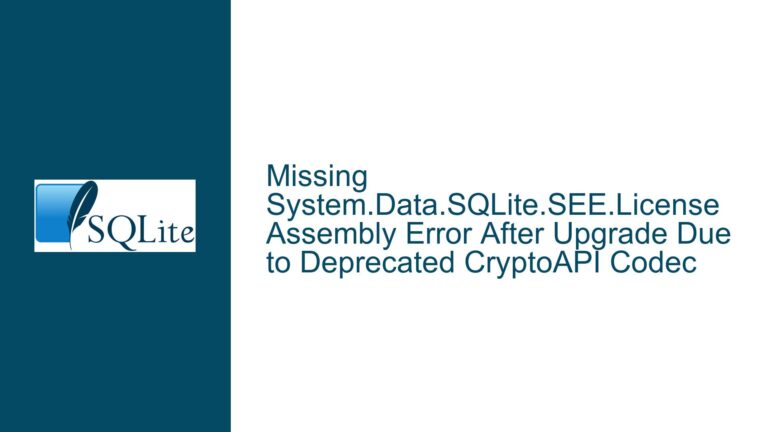System.Data.SQLiteConnection DbProviderFactory Implementation Issue
Issue Overview: System.Data.SQLiteConnection Fails to Override DbProviderFactory
The core issue revolves around the System.Data.SQLiteConnection class, which inherits from System.Data.Common.DbConnection. While System.Data.SQLiteConnection implements and overrides several members as expected, it fails to override the DbProviderFactory property, which is a critical virtual property defined in the base class System.Data.Common.DbConnection. The DbProviderFactory property is intended to return an instance of the appropriate DbProviderFactory for the connection, enabling the System.Data.Common.DbProviderFactories.GetFactory(DbConnection) method to function correctly.
In the current implementation, the DbProviderFactory property in System.Data.SQLiteConnection is not overridden, and thus it defaults to returning null. This behavior is problematic because it prevents the GetFactory method from retrieving the correct DbProviderFactory instance for SQLite connections. Specifically, the GetFactory method should return an instance of System.Data.SQLite.SQLiteFactory, but instead, it returns null due to the lack of proper implementation.
The issue is further complicated by the fact that the official documentation for System.Data.SQLite suggests that the DbProviderFactory property is implemented and should return the SQLiteFactory instance. However, upon closer inspection, it appears that this implementation is only present in certain assemblies, such as stub.system.data.sqlite.core.netframework, and is missing in others, such as stub.system.data.sqlite.core.netstandard. This discrepancy raises questions about why the implementation is inconsistent across different packages and whether there are specific reasons for this inconsistency.
Possible Causes: Inconsistent Implementation Across Assemblies
The root cause of this issue lies in the inconsistent implementation of the DbProviderFactory property across different assemblies of the System.Data.SQLite library. Specifically, the property is correctly implemented in the stub.system.data.sqlite.core.netframework assembly but is missing in the stub.system.data.sqlite.core.netstandard assembly. This inconsistency can be attributed to several potential factors:
Assembly-Specific Build Configurations: The
System.Data.SQLitelibrary may have different build configurations for different target frameworks (e.g., .NET Framework vs. .NET Standard). These configurations might include or exclude certain members based on the target framework’s capabilities or requirements. In this case, theDbProviderFactoryproperty might have been intentionally excluded from the .NET Standard build due to differences in howDbProviderFactoryis handled in .NET Standard compared to the .NET Framework.Historical or Legacy Code: The
System.Data.SQLitelibrary has undergone several updates and changes over the years. It is possible that theDbProviderFactoryproperty was implemented in earlier versions targeting the .NET Framework but was overlooked or intentionally omitted when the library was adapted for .NET Standard. This could be due to differences in the underlying architecture or the assumption that the property was not necessary for .NET Standard.Documentation vs. Implementation Discrepancy: The official documentation for
System.Data.SQLiteindicates that theDbProviderFactoryproperty should return theSQLiteFactoryinstance. However, this documentation might have been generated from a specific assembly (e.g.,stub.system.data.sqlite.core.netframework) where the property is implemented. The discrepancy between the documentation and the actual implementation in other assemblies (e.g.,stub.system.data.sqlite.core.netstandard) suggests that the documentation may not accurately reflect the state of all assemblies.Third-Party Library Dependencies: The
System.Data.SQLitelibrary may depend on third-party libraries or components that are not fully compatible with all target frameworks. For example, the implementation ofDbProviderFactorymight rely on features or APIs that are available in the .NET Framework but not in .NET Standard. As a result, the property might have been excluded from the .NET Standard build to avoid compatibility issues.Maintenance and Resource Constraints: Maintaining a library that targets multiple frameworks can be resource-intensive. It is possible that the developers of
System.Data.SQLiteprioritized certain features or fixes for specific frameworks based on user demand or resource availability. The omission of theDbProviderFactoryproperty in the .NET Standard build could be a result of these prioritization decisions.
Troubleshooting Steps, Solutions & Fixes: Addressing the DbProviderFactory Implementation
To resolve the issue of the missing DbProviderFactory implementation in System.Data.SQLiteConnection, several steps can be taken. These steps involve both short-term workarounds and long-term solutions to ensure that the DbProviderFactory property is correctly implemented across all target frameworks.
1. Verify the Target Framework and Assembly
Before attempting any fixes, it is essential to verify the target framework and assembly being used in the project. If the project is targeting .NET Standard, it is likely using the stub.system.data.sqlite.core.netstandard assembly, where the DbProviderFactory property is missing. In contrast, if the project is targeting the .NET Framework, it might be using the stub.system.data.sqlite.core.netframework assembly, where the property is implemented.
To verify the target framework, check the project file (e.g., .csproj) for the <TargetFramework> element. For example:
<TargetFramework>netstandard2.0</TargetFramework>
or
<TargetFramework>net472</TargetFramework>
Once the target framework is confirmed, inspect the referenced assemblies to determine which version of System.Data.SQLite is being used. This can be done by examining the bin directory or using a tool like ILSpy to inspect the assembly metadata.
2. Implement a Custom DbProviderFactory
If the DbProviderFactory property is missing in the assembly being used, a temporary workaround is to implement a custom DbProviderFactory that returns the SQLiteFactory instance. This can be achieved by creating a subclass of System.Data.SQLiteConnection and overriding the DbProviderFactory property.
Here is an example of how to implement a custom DbProviderFactory:
public class CustomSQLiteConnection : System.Data.SQLite.SQLiteConnection
{
protected override DbProviderFactory DbProviderFactory => System.Data.SQLite.SQLiteFactory.Instance;
public CustomSQLiteConnection(string connectionString) : base(connectionString)
{
}
}
In this example, the CustomSQLiteConnection class inherits from System.Data.SQLite.SQLiteConnection and overrides the DbProviderFactory property to return the SQLiteFactory instance. This custom connection class can then be used in place of the standard System.Data.SQLiteConnection class.
3. Use Reflection to Set the DbProviderFactory
Another workaround is to use reflection to set the DbProviderFactory property at runtime. This approach involves accessing the internal or private members of the System.Data.SQLiteConnection class and setting the DbProviderFactory property manually.
Here is an example of how to use reflection to set the DbProviderFactory property:
var connection = new System.Data.SQLite.SQLiteConnection("Data Source=:memory:");
var dbProviderFactoryField = typeof(System.Data.Common.DbConnection)
.GetField("_dbProviderFactory", System.Reflection.BindingFlags.NonPublic | System.Reflection.BindingFlags.Instance);
if (dbProviderFactoryField != null)
{
dbProviderFactoryField.SetValue(connection, System.Data.SQLite.SQLiteFactory.Instance);
}
In this example, reflection is used to access the _dbProviderFactory field of the System.Data.Common.DbConnection class and set it to the SQLiteFactory instance. This approach should be used with caution, as it relies on internal implementation details that may change in future versions of the library.
4. Update or Switch Assemblies
If the project is targeting .NET Standard and the DbProviderFactory property is missing, consider updating the System.Data.SQLite library to a version where the property is implemented. Alternatively, if the project can target the .NET Framework, switching to the stub.system.data.sqlite.core.netframework assembly may resolve the issue.
To update the library, use the NuGet Package Manager to check for updates to the System.Data.SQLite package. If an update is available, install the latest version and verify whether the DbProviderFactory property is now implemented.
If switching to the .NET Framework is an option, modify the project file to target the .NET Framework instead of .NET Standard. For example:
<TargetFramework>net472</TargetFramework>
After changing the target framework, ensure that the stub.system.data.sqlite.core.netframework assembly is referenced and that the DbProviderFactory property is available.
5. Contribute to the Open-Source Project
For a long-term solution, consider contributing to the System.Data.SQLite open-source project to ensure that the DbProviderFactory property is implemented consistently across all target frameworks. This involves cloning the repository, making the necessary changes, and submitting a pull request.
Here are the steps to contribute to the project:
- Clone the Repository: Clone the
System.Data.SQLiterepository from its official source (e.g., GitHub). - Make the Changes: Locate the source file where the
System.Data.SQLiteConnectionclass is defined and add theDbProviderFactoryproperty implementation for the .NET Standard build. - Build and Test: Build the library for all target frameworks and run the tests to ensure that the changes do not introduce any regressions.
- Submit a Pull Request: Submit a pull request with the changes and a detailed explanation of the issue and the proposed fix.
By contributing to the project, you can help ensure that the DbProviderFactory property is implemented consistently across all assemblies, benefiting the entire community.
6. Use an Alternative Library
If the issue persists and none of the above solutions are feasible, consider using an alternative library that provides similar functionality. For example, Microsoft’s Microsoft.Data.Sqlite library is a lightweight and modern alternative to System.Data.SQLite that is designed specifically for .NET Core and .NET Standard.
To switch to Microsoft.Data.Sqlite, remove the System.Data.SQLite package and install the Microsoft.Data.Sqlite package via NuGet. Update the code to use the new library’s classes and methods, ensuring that the DbProviderFactory property is correctly implemented.
Here is an example of how to use Microsoft.Data.Sqlite:
using Microsoft.Data.Sqlite;
var connection = new SqliteConnection("Data Source=:memory:");
var factory = SqliteFactory.Instance;
In this example, the SqliteConnection class from Microsoft.Data.Sqlite is used, and the SqliteFactory instance is readily available.
Conclusion
The issue of the missing DbProviderFactory implementation in System.Data.SQLiteConnection is a significant one that can impact the functionality of applications relying on this property. By understanding the root causes and exploring the various troubleshooting steps and solutions, developers can effectively address this issue and ensure that their applications function as intended. Whether through temporary workarounds, updating libraries, or contributing to the open-source project, there are multiple paths to resolving this issue and improving the overall reliability of the System.Data.SQLite library.






